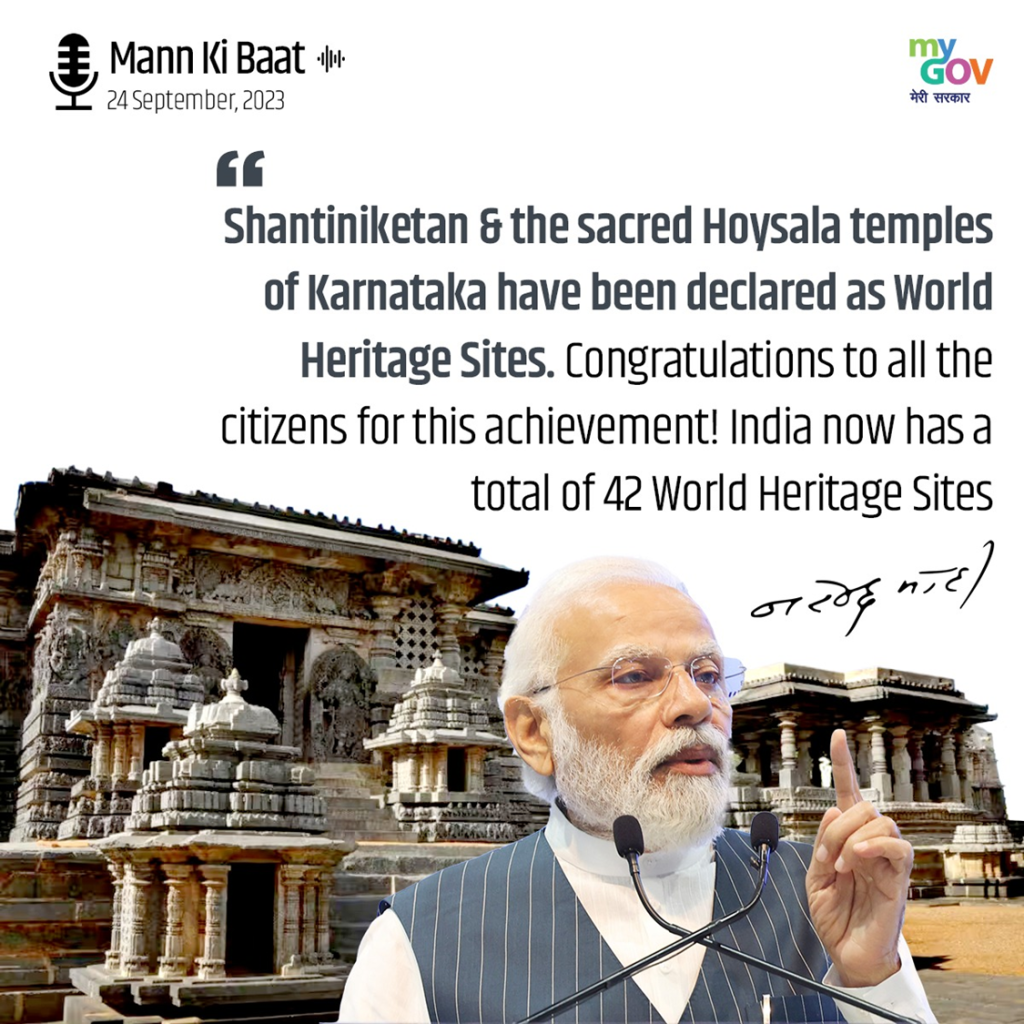India is home to a rich cultural and natural heritage, with its vast history and diverse geography. UNESCO (United Nations Educational, Scientific and Cultural Organization) recognizes places of outstanding cultural, historical, and environmental significance by designating them as World Heritage Sites.
AFCAT 1 2025 Exam Static GK – World Heritage Sites In India
Cultural World Heritage Sites in India
India’s cultural heritage spans centuries, and the following sites reflect its rich historical and architectural legacy:
- Taj Mahal (Uttar Pradesh):
- Year of Inscription: 1983
- Significance: One of the most recognized monuments in the world, this white marble mausoleum was built by Mughal Emperor Shah Jahan in memory of his wife Mumtaz Mahal. It stands as a symbol of love and a masterpiece of Mughal architecture.
- Ajanta Caves (Maharashtra):
- Year of Inscription: 1983
- Significance: These 30 rock-cut Buddhist cave monuments date back to the 2nd century BCE and include ancient murals and sculptures, representing the artistic brilliance of Indian craftsmen during the Gupta period.
- Ellora Caves (Maharashtra):
- Year of Inscription: 1983
- Significance: These caves are a collection of Hindu, Buddhist, and Jain rock-cut temples built between the 6th and 10th centuries. The Kailasa Temple at Ellora is an engineering marvel carved out of a single rock.
- Sun Temple, Konark (Odisha):
- Year of Inscription: 1984
- Significance: This 13th-century temple, dedicated to the Sun God, is shaped like a giant chariot with intricately carved stone wheels, pillars, and walls. It is a superb example of Kalinga architecture.
- Khajuraho Group of Monuments (Madhya Pradesh):
- Year of Inscription: 1986
- Significance: Known for their erotic sculptures, the temples at Khajuraho reflect the artistic and cultural sensibilities of the Chandela dynasty. The temples are dedicated to Hindu and Jain deities.
- Fatehpur Sikri (Uttar Pradesh):
- Year of Inscription: 1986
- Significance: A historical city built by Mughal Emperor Akbar, Fatehpur Sikri was the capital of the Mughal Empire for a brief period. The city is known for its stunning red sandstone buildings and structures like Buland Darwaza and Panch Mahal.
- Red Fort Complex (Delhi):
- Year of Inscription: 2007
- Significance: This historic fort served as the main residence of the Mughal emperors for nearly 200 years. It is also the place where India’s Prime Minister addresses the nation on Independence Day.
- Mahabalipuram Group of Monuments (Tamil Nadu):
- Year of Inscription: 1984
- Significance: The site features a collection of temples, rock-cut caves, and giant open-air bas-reliefs, showcasing the Pallava dynasty’s art and architecture.
- Qutub Minar and its Monuments (Delhi):
- Year of Inscription: 1993
- Significance: Qutub Minar, the tallest brick minaret in the world, is part of a complex that includes the Iron Pillar, Alai Darwaza, and the remains of several Mughal buildings. It symbolizes the early Indo-Islamic architectural developments.
- Hampi (Karnataka):
- Year of Inscription: 1986
- Significance: Once the capital of the Vijayanagara Empire, Hampi is famous for its spectacular ruins that reflect the grandeur of a flourishing Hindu kingdom. Key attractions include the Virupaksha Temple and Vittala Temple.
Natural World Heritage Sites in India
India’s natural World Heritage Sites highlight the country’s incredible biodiversity and unique landscapes. These sites are vital for conservation efforts and scientific study.
- Kaziranga National Park (Assam):
- Year of Inscription: 1985
- Significance: Known for its population of the Indian one-horned rhinoceros, Kaziranga is a sanctuary for wildlife and an important wetland ecosystem in the northeastern part of India.
- Sundarbans National Park (West Bengal):
- Year of Inscription: 1987
- Significance: The world’s largest mangrove forest and home to the Bengal tiger, the Sundarbans is an important region for biodiversity, especially for its role in coastal protection and as a breeding ground for numerous species.
- Western Ghats (Multiple States):
- Year of Inscription: 2012
- Significance: Spanning multiple states, the Western Ghats are a biodiversity hotspot known for their endemic species of flora and fauna. This mountain range is vital for the ecological balance of South India.
- Manas Wildlife Sanctuary (Assam):
- Year of Inscription: 1985
- Significance: A UNESCO-listed tiger and elephant reserve, Manas is known for its rare and endangered species, including the pygmy hog and golden langur.
Mixed World Heritage Sites (Cultural and Natural)
Some sites in India represent a combination of cultural significance and natural beauty, offering a dual experience for visitors.
- Khangchendzonga National Park (Sikkim):
- Year of Inscription: 2016
- Significance: This mixed heritage site is home to the majestic Mount Khangchendzonga, the third-highest peak in the world, and holds deep cultural significance for the local Sikkimese people. The park is also a haven for unique flora and fauna.
Other Notable World Heritage Sites
- Rani ki Vav (Gujarat):
- Year of Inscription: 2014
- Significance: This stepwell was constructed during the reign of the Solanki dynasty and is an architectural marvel, showcasing intricate carvings depicting scenes from Hindu mythology.
- Great Living Chola Temples (Tamil Nadu):
- Year of Inscription: 1987
- Significance: These temples, built during the reign of the Chola dynasty, are a testament to the architectural and artistic achievements of the time. The Brihadeshwara Temple in Thanjavur is a highlight.
- Hill Forts of Rajasthan:
- Year of Inscription: 2013
- Significance: These forts, including Chittorgarh, Kumbhalgarh, and Jaisalmer Fort, represent the valour and architectural brilliance of the Rajput kings.
- The Historic City of Ahmedabad (Gujarat):
- Year of Inscription: 2017
- Significance: Recognized for its ancient architectural sites, this walled city is the first Indian city to be designated a UNESCO World Heritage City.
- Dholavira (Gujarat):
- Year of Inscription: 2021
- Significance: This Harappan-era city is one of the most well-preserved archaeological sites of the Indus Valley Civilization, showcasing urban planning and water management systems.
Conclusion
India’s World Heritage Sites are a reflection of its vast cultural and natural wealth. For AFCAT 1 2025 Exam aspirants, being familiar with these sites is essential, as they are frequently featured in static GK questions. These sites serve as milestones in India’s history, culture, and biodiversity, making them key to understanding the country’s diverse heritage.






















